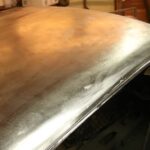Classic car ownership is a labor of love. Maintaining these vehicles requires a deep understanding of their mechanics and a dedication to preserving their originality. While modern cars rely heavily on computer diagnostics, classic cars often require a more hands-on approach, especially when it comes to tuning. This article explores the crucial role of pre-tuning preparation before a classic car undergoes rolling road tuning for optimal performance.
Rolling road tuning, also known as dyno tuning, is a process where a vehicle is placed on a dynamometer – a device that measures force, torque, and power. The car is run through various RPM ranges and load conditions, allowing technicians to fine-tune the engine for optimal power output and efficiency. However, simply driving a classic car onto a rolling road without proper preparation can be a costly and ineffective exercise.
A comprehensive pre-tune inspection and adjustment are crucial for maximizing the benefits of a rolling road session. This foundational work ensures that the engine is in good health and operating within its design parameters before any performance enhancements are attempted. Think of it as building a house – you need a solid foundation before you can add the walls and roof. Similarly, a well-tuned engine relies on a series of fundamental checks and adjustments.
This pre-tuning process typically includes the following:
-
Electrical System Checks: Verifying battery voltage, ignition coil resistance, and ensuring proper grounding are essential for a strong and consistent spark. A weak spark can lead to misfires and poor performance.
-
Spark Plug Inspection and Gapping: Examining spark plugs for wear and tear and ensuring they are correctly gapped is crucial for efficient combustion. Incorrectly gapped plugs can lead to incomplete burning of fuel and reduced power.
-
Carburetor Balancing and Adjustment: This involves synchronizing the carburetors, ensuring consistent fuel delivery to each cylinder. Adjusting choke jet height, fast idle airflow, and idle jet height all contribute to smooth running and efficient fuel consumption.
-
Ignition Timing and Scatter Test: Verifying the ignition timing and checking for any scatter (variation in timing) ensures that the spark occurs at the optimal moment for efficient combustion. Excessive scatter can lead to poor performance and engine damage.
-
Fuel System Checks: This includes inspecting fuel lines for leaks and ensuring proper fuel pressure. A reliable fuel supply is critical for consistent engine performance.
-
Other Essential Checks: These include visual inspections for vacuum leaks, checking engine compression, and examining the overall condition of the engine components.
By addressing these fundamental aspects before a rolling road session, you ensure that the engine is operating at its best and that the tuner can focus on fine-tuning the fuel and ignition maps for optimal performance under load. Without this foundational work, the rolling road session may only mask underlying issues, leading to suboptimal results and potential future problems.
A thorough pre-tuning process not only saves time and money on the rolling road but also provides a baseline for future maintenance and troubleshooting. Detailed documentation of the initial settings, adjustments made, and observed values allows for easier diagnosis and correction of any issues that may arise later.
In conclusion, Classic Car Rolling Road Tuning is most effective when built upon a solid foundation of pre-tuning preparation. This groundwork ensures the engine is healthy, functioning correctly, and ready for the fine-tuning that a rolling road session provides. Remember, a well-tuned classic car is not just about peak performance but also about reliability, longevity, and the enjoyment of driving a piece of automotive history. Ensure your classic car receives the proper preparation before its rolling road tuning to unlock its full potential.


